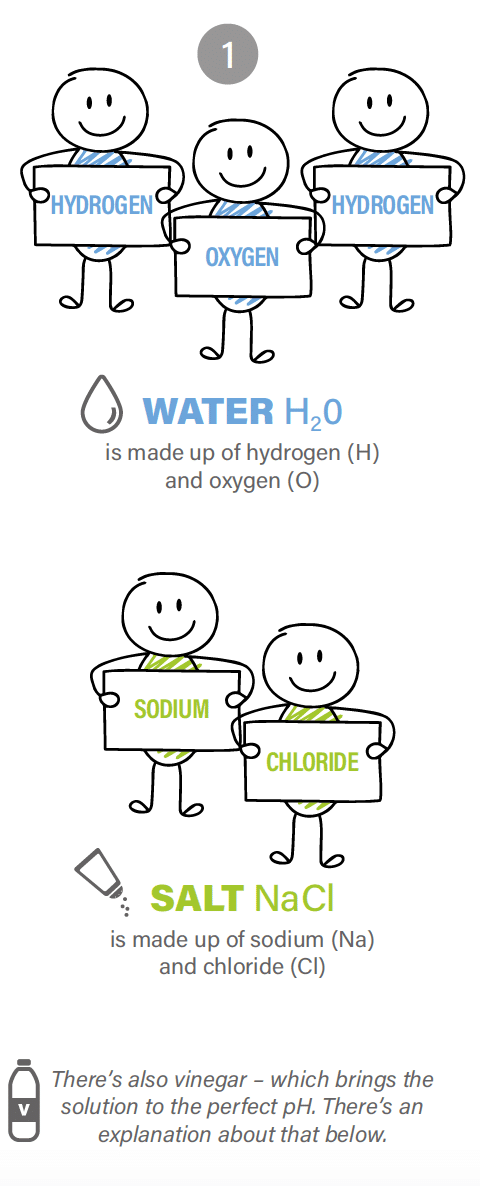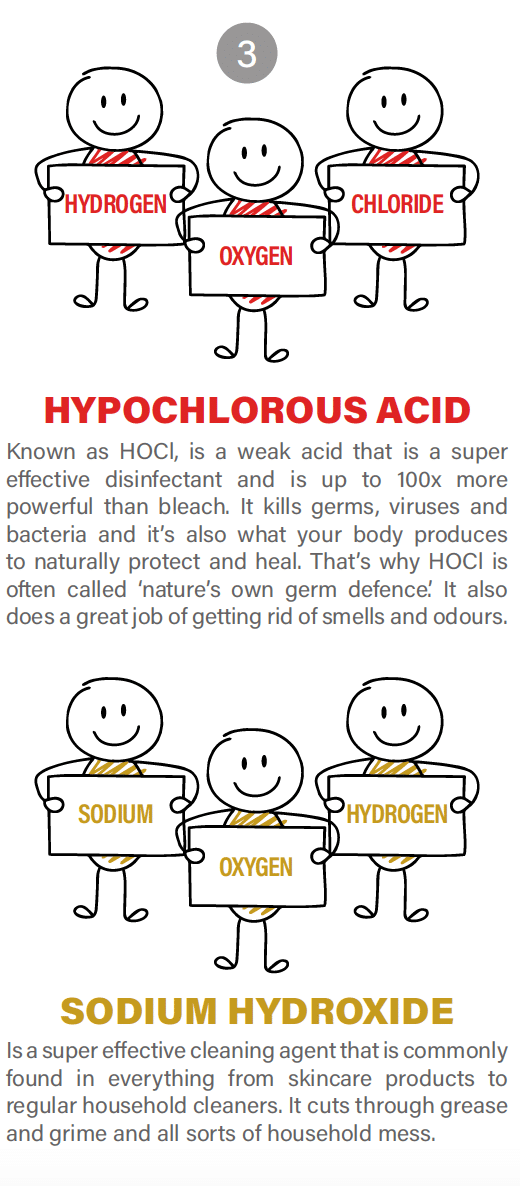
UNDERSTANDING THE SCIENCE BEHIND ELECTROLYSED WATER
What is electrolysed water and how do you make it?
Electrolysed water is a powerful solution that you can use to clean and disinfect pretty much everything in your home. The process of running electricity through a solution, such as salt and water, is known as electrolysis.
All it takes is three household ingredients, and your EVO Home will turn them into a powerful new solution that you can use to clean, disinfect and deodorise. That means no preservatives, no colourants, no fragrances, and no harmful toxins to irritate, cause allergies or harm the environment.

But how exactly does this work? Let’s explain!



What about the Vinegar?
Vinegar is a weak acid and used to balance the pH of the solution so that the maximum amount of HOCl is created.
What does the medical industry classify electrolysed water as?
In October 2002, the FDA cleared Electrolysed Water (aka superoxidized water) as a high-level disinfectant.
“The microbicidal activity of superoxidized water has been examined and the concept of electrolysing saline to create a disinfectant or antiseptics is appealing because the basic materials of saline and electricity are inexpensive and the end product (i.e. water) does not damage the environment.”
“Superoxidized water has been tested against bacteria, mycobacteria, viruses, fungi and spores. Freshly generated superoxidized water is rapidly effective (<2 minutes) in achieving a 5-log10 (99.99%) reduction of pathogenic microorganisms (i.e. M. tuberculosis, M. chelone, poliovirus, HIV, multidrug resistant S. aureus, E. coli, Candida albicans, Enterococcus faecalis, P. aeruginosa)”
What makes electrolysed water an effective disinfectant?
The active compound in electrolyzed water is Hypochlorous Acid (HOCl). It kills bacteria and viruses and is EPA approved for use as a disinfectant and sanitiser. HOCl is 99.9% effective and is up to 100 times more efficient at killing bacteria than chlorine bleach.
What strength of HOCl can I make with the EVO Home?
Disinfectant strength/concentrations are measured in ‘parts per million’ – PPM. The EVO Home is capable of making differing strengths of HOCl by adjusting the salt to water ratio and the duration of the electrolysis process. HOCl solutions of up to 200ppm are more than adequate and are approved by the EPA for use on all surfaces, including food preparation surfaces, without the need to wipe away or rinse after use. The EPA approves the use of HOCl on fresh produce to remove pesticides and bacteria but requires a rinse off if the PPM is greater than 50.
With 1 x activation and 2g of salt, EVO Home will create HOCl at 105ppm. If you’d like to make a stronger disinfectant you can activate the solution a second time to create a HOCl solution of 200ppm (without adding more salt).
See the table below for more detailed information.

Is electrolysed water safe?
Electrolysed water is non-toxic and safe for people, pets and the environment. Electrolysed water is the only natural cleaner with no added fragrances, dyes, preservatives, alcohol or surfactants. It is advisable to be mindful of the amount of toxic chemicals you are exposing yourself and your family to on a daily basis from other household cleaners.
Read the scientific study on the safety of electrolysed water
Electrolysed water vs bleach?
Electrolysed water and bleach both contain chlorine and both can be used to disinfect. However, electrolysed water (HOCl) is safer and more gentle to use with none on the dangers associated with handling undiluted bleach.
FAQ’s
How long does electrolysed water last for?
What is PPM?
Does it kill bacteria and viruses?
Does it kill COVID-19?
Is there any 3rd party testing on HOCl and the EVO Home on COVID-19?
Does it get rid of smells and odour?
Does it treat mould and fungus?
What is the difference between bleach and HOCl?
HOCl and bleach both contain chlorine and both can be used to disinfect. However, HOCl is safer and more gentle to use with none on the dangers associated with handling undiluted bleach. Click here to learn more about chlorine, HOCl and bleach
